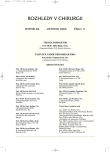Treatment of Iatrogenic Bile Duct Lesions from Laparoscopic Cholecystectomy
Behandlung von iatrogenen Gallengangverletzungen im Rahmen der laparoskopischen Cholecystektomie
Trotz flächendeckender Einführung der laparoskopischen Cholecystektomie ist die Inzidenz an iatrogenen Gallengangverletzungen im Zusammenhang mit diesem Eingriff im Vergleich zur offenen Cholecystektomie nach wie vor etwa um das Doppelte erhöht. Begünstigt wird die iatrogene Gallengangverletzung durch pathologische anatomische Verhältnisse, Varianten der Gallengangsanatomie und mangelnde chirurgische Erfahrung. Die adäquate Behandlung der iatrogenen Gallengangläsion ist abhängig vom vorliegenden Verletzungsmuster und dem diagnostischen Zeitintervall. Während periphere Leckagen und kurzstreckige Stenosen in der Regel erfolgreich endoskopisch therapiert werden können, erfordern komplexe Läsionen die chirurgische Rekonstruktion. Die besten Ergebnisse im Langzeitverlauf werden mit der spannungsfreien End-zu-Seit Roux-Y Hepaticojejunostomie erreicht.
Schlüsselwörter:
Laparoskopische Cholecystektomie – Iatrogene Gallengangsverletzung
Authors:
Schmidt S.-C.; J. M. Langrehr; G. Schumacher; P. Neuhaus
Authors‘ workplace:
Campus Virchow Klinikum, BRD
; Klinik für Allgemein-, Visceral- und Transplantationschirurgie, Universitätsmedizin Berlin, Charite
Published in:
Rozhl. Chir., 2005, roč. 84, č. 11, s. 567-572.
Category:
Monothematic special - Original
Overview
Injuries of the biliary tract following laparoscopic cholecystectomy have increased with the widespread use of the procedure. Compared to the conventional open choelycstectomy, the incidence of bile duct injuries is at least twofold higher after the laparoscopic procedure. A number of risk factors for the occurrence of bile duct injuries have been well described, including severe inflammation, bleeding, anatomical variations and lack of surgical experience. The appropriate management of bile duct injuries depends on the time of diagnosis after the injury and the type of injury. While peripheral leakages and short strictures can be treated endoscopically, extended injuries and long strictures require surgical reconstruction. The best long-term results are achieved with a a tension-free, end-to-side mucosa-to-mucosa Roux-Y hepaticojejunostomy.
Key words:
laparoscopic cholecystectomy – bile duct injury
Labels
Surgery Orthopaedics Trauma surgeryArticle was published in
Perspectives in Surgery

2005 Issue 11
- Metamizole vs. Tramadol in Postoperative Analgesia
- Metamizole at a Glance and in Practice – Effective Non-Opioid Analgesic for All Ages
- Metamizole in the Treatment of Acute Postoperative Pain
Most read in this issue
- Retromuscular Mesh Repair of a Hernia in a Scar According to Rives – Our First Experience
- Small Bowel Perforation as a Late Complication after Laparoscopic Hernioplasty
- Fast Track in Surgery
- Management of Pseudoarthrosis of the Navicular Bone of the Wrist Using the Synthes 3.0
